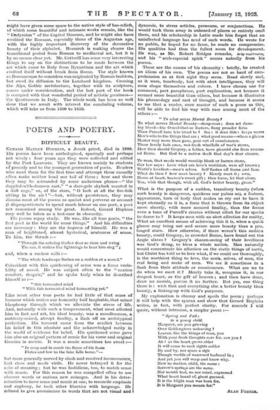A HISTORY OF ART.f HISTORIES of art are apt, if
short, to degenerate into mere individual and inconclusive pronouncements, or, if long, into endless masses of detail, a forest hidden by the trees. Into neither of these faults has Mr. Cotterill fallen. We may not agree with all his judgments, but he always gives us reasons for his conclusions, which as a rule are convincing. The number of facts stated, and actual specimens of art examined, is very large, but there is no confusion, as the writer proceeds on lines of argument carefully thought out and aptly illustrated. The narrative begins with Egypt, and goes on through Assyria to the Greeks, Romans, Byzan- tines, and also treats of the Romanesque and Northern Gothic, and ends with Italy in the Quattrocento, dealing with Archi- tectural Sculpture and Painting. To have done all this in 400 pages of most interesting reading is no small achievement.
Mr. Cotterill is exceedingly orthodox in his views of the inferiority of the sculpture of the Egyptians to that of the Athenians. He does not, perhaps, quite realize why some people find qualities missing in the work of the Greeks present in the far less realistic sculpture of the Egyptians. The Hellenic sculptors make us feel that if we were only fortunate we might meet the living counterparts of their works moving about the world as in some glorified tableau vivant. There is nothing impossible in their conceptions. The Egyptians, like Michelangelo, give us " the light that never was on sea or land."
Mr. Cotterill is so oppressed by the formality of Egyptian design that he is inclined to attribute to pure conventionalism and hierarchical customs things which quite possibly had an aesthetic origin. Take, for instance, the painting of the birdcatcher ; it is likely that the device of the full face, chest and arms, and profile head and legs, may not be dictated by a " Memphite formula," but by a desire to preserve the flatness of the decorated wall by the avoiding of foreshortening.
In his discussion of Roman Sculpture we think the author • In and Around Yunnan Fou. By Gabrielle M. Vassal. London: Helnemann. [10a. ed. net.] t A History of Art. By H. B. CcatertIL Vol. L: Down to the Age at Raphael London: Barrap and Co. [g2 ga.] might have given some space to the native style of bas-reliefs, of which some beautiful and intimate works remain, like the " Endymion " of the Capitol Museum, and he might also have credited the Romans, especially those of the Augustan age, with the highly important discovery of the decorative beauty of their alphabet. Research is making clearer the transitional period from Roman to mediaeval art, but it is by no means clear yet. Mr. Cotterill has some very interesting things to say on the distinctions to be made between the art which came to Italy from Byzantium and the art which evolved itself without break from Rome. The style known as Romanesque he considers was originated by Roman builders, but owed its diffusion to the Lombard kingdom. Crossing the Alps, Gothic architecture, together with its sculpture, comes under consideration, and the last part of the book is occupied with that wonderful period of artistic greatness— the Quattrocento in Italy. The whole work has been so well done that we await with interest the concluding volume, which will take us from 1500 to 1830.















































 Previous page
Previous page